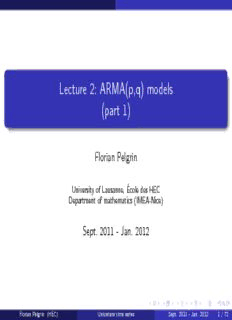
Lecture 2: ARMA(p,q) PDF
Preview Lecture 2: ARMA(p,q)
Lecture 2: ARMA(p,q) models (part 1) Florian Pelgrin UniversityofLausanne,E´coledesHEC Departmentofmathematics(IMEA-Nice) Sept. 2011 - Jan. 2012 FlorianPelgrin (HEC) Univariatetimeseries Sept.2011-Jan.2012 1/72 Introduction Motivation Characterize the main properties of AR(p) models. Estimation of AR(p) models FlorianPelgrin (HEC) Univariatetimeseries Sept.2011-Jan.2012 2/72 Introduction Road map 1 Introduction 2 AR(1) model 3 Application with an AR(1) model 4 Autoregressive model of order p, AR(p) 5 Appendix FlorianPelgrin (HEC) Univariatetimeseries Sept.2011-Jan.2012 3/72 AR(1)model Autoregressive models 2. Autoregressive model of order 1, AR(1) Definition A stochastic process (Xt)t∈Z is said to be an autoregressive process of order 1 if it satisfies the following equation : X = µ+φX +(cid:15) ∀t t t−1 t where φ (cid:54)= 0, µ is a constant term, ((cid:15)t)t∈Z is a weak white noise process with expectation zero and variance σ2 ((cid:15) ∼ WN(0,σ2)). (cid:15) t (cid:15) FlorianPelgrin (HEC) Univariatetimeseries Sept.2011-Jan.2012 4/72 AR(1)model Simulation of an AR(1) with phi=-0.5 Simulation of an AR(1) with phi=0 4 4 2 2 0 0 -2 -2 -4 -4 0 100 200 300 0 100 200 300 Simulation of an AR(1) with phi=0.5 Simulation of an AR(1) with phi=0.9 4 10 2 5 0 0 -2 -5 -4 -10 0 100 200 300 0 100 200 300 FlorianPelgrin (HEC) Univariatetimeseries Sept.2011-Jan.2012 5/72 AR(1)model Remarks : 1. In lag notation, one has : Φ(L)X ≡ (1−φL)X = µ+(cid:15) t t t 2. The previous process can be written in mean-deviation as follows : X˜ = φX˜ +(cid:15) t t−1 t where µ X˜ = X − t t 1−φ since (cid:18) (cid:19) µ µ X − = φ X − +(cid:15) ⇔ X = µ+φX +(cid:15) t t−1 t t t−1 t 1−φ 1−φ FlorianPelgrin (HEC) Univariatetimeseries Sept.2011-Jan.2012 6/72 AR(1)model Remarks (cont’d) : 3. For each date, one has an equation relating the value of X for that date to its previous value and the current value of (cid:15). Suppose that X is known, one gets : −1 X = µ+φX +(cid:15) 0 −1 0 X = µ+φX +(cid:15) 1 0 1 X = µ+φX +(cid:15) 2 1 2 . . . X = µ+φX +(cid:15) . t t−1 t 4. Such a specification is a stochastic difference equation of order one. it can be solved by recursive substitution. FlorianPelgrin (HEC) Univariatetimeseries Sept.2011-Jan.2012 7/72 AR(1)model Remarks (cont’d) : 5. Solution by recursive substitution yields : X = µ+φX +(cid:15) t t−1 t = µ+φ(µ+φX +(cid:15) )+(cid:15) =(1+φ)µ+φ2X +(cid:15) +φ(cid:15) t−2 t−1 t t−2 t t−1 = (1+φ)µ+φ2(µ+φX +(cid:15) )+(cid:15) +φ(cid:15) t−3 t−2 t t−1 = (1+φ+φ2)µ+φ2X +(cid:15) +φ(cid:15) +φ2(cid:15) t−3 t t−1 t−2 . . . = (1+φ+···+φt)µ+φt+1X +(cid:15) +φ(cid:15) +···+φt(cid:15) −1 t t−1 0 = 1−φt+1µ+φt+1X +(cid:88)t φk(cid:15) 1−φ −1 t−k k=0 = 1−φt+1µ+φt+1X +(cid:88)t ψ (cid:15) 1−φ −1 k t−k k=0 where ψ =φk. k FlorianPelgrin (HEC) Univariatetimeseries Sept.2011-Jan.2012 8/72 AR(1)model Remarks (cont’d) : 6. Alternatively, solving forward h periods from time t (omitting the constant term) : h Y =φh+1X +(cid:88)ψ (cid:15) . t+h t−1 k t+h−k k=0 The dynamic multiplier h-period ahead is : dX t+h =φh =ψ . d(cid:15) h t The impulse-response function is obtained by plotting ψ versus h. h The cumulative impact (up to horizon h) of a shock is : h (cid:88) ψ k k=1 The long-run cumulative impact is : ∞ (cid:88) ψ k k=1 FlorianPelgrin (HEC) Univariatetimeseries Sept.2011-Jan.2012 9/72 AR(1)model Stationarity and stability conditions If |φ| < 1, then : lim φk = lim φ = 0 k k→∞ k→∞ and the stable and weak stationary solution (Wold’s representation) for the AR(1) becomes (the limiting behavior of the recursive solution of the first-order stochastic difference equation) : ∞ µ (cid:88) X = + φk(cid:15) t t−k 1−φ k=0 and the long-run cumulative impact is 1 . 1−φ If |φ| = 1, then X is a random walk with drift and is not stationary. t If |φ| > 1, there exists a non-causal stationary solution that we rule out. FlorianPelgrin (HEC) Univariatetimeseries Sept.2011-Jan.2012 10/72
Description: